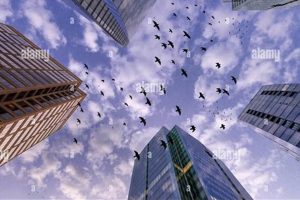A skyscraper is a continuously habitable high-rise building that has over 40 floors and is taller than 150 meters (492 feet). The Council on Tall Buildings and Urban Habitat (CTBUH) classifies skyscrapers based on height, with three main categories: tall buildings (150 to 299 meters), supertall buildings (300 to 600 meters), and megatall buildings (over 600 meters).
Skyscrapers are important for several reasons. First, they can accommodate a large number of people and businesses in a relatively small area, which can help to reduce urban sprawl and traffic congestion. Second, skyscrapers can be designed to be energy-efficient and sustainable, which can help to reduce the environmental impact of cities. Third, skyscrapers can be iconic landmarks that symbolize the economic and cultural vitality of a city.
The history of skyscrapers can be traced back to the late 19th century, when the invention of the elevator made it possible to build taller buildings. The first skyscraper was the Home Insurance Building in Chicago, which was completed in 1885 and had 10 stories. Since then, skyscrapers have become increasingly common in cities around the world, and they continue to be an important part of the urban landscape.
1. Height
Height is one of the most important factors in determining whether or not a building is considered a skyscraper. The Council on Tall Buildings and Urban Habitat (CTBUH) defines a skyscraper as a building that is at least 150 meters (492 feet) tall. However, there is no official height limit for skyscrapers, and some of the tallest buildings in the world are over 800 meters (2,600 feet) tall.
- Height and Function
The height of a skyscraper is often dictated by its function. For example, residential skyscrapers are typically shorter than commercial skyscrapers, because there is less need for vertical space in residential buildings. On the other hand, commercial skyscrapers need to be tall in order to accommodate large numbers of tenants and employees.
- Height and Engineering
The height of a skyscraper is also limited by engineering constraints. The taller a building is, the more difficult it is to design and construct it safely and efficiently. Engineers need to take into account factors such as wind load, seismic activity, and fire safety when designing skyscrapers.
- Height and Aesthetics
The height of a skyscraper can also be influenced by aesthetic considerations. Some architects believe that skyscrapers should be tall and slender, while others believe that they should be more squat and imposing. The height of a skyscraper can also be used to create a sense of drama or excitement.
- Height and Sustainability
The height of a skyscraper can also impact its sustainability. Taller buildings require more energy to heat and cool, and they can also create more wind resistance, which can lead to increased air pollution. However, some architects are designing skyscrapers that are more energy-efficient and sustainable, and these buildings are becoming increasingly common.
In conclusion, the height of a skyscraper is a key factor in determining its classification, function, engineering, aesthetics, and sustainability. Skyscrapers are an important part of the modern cityscape, and they continue to push the boundaries of architectural design and engineering.
2. Floors
The number of floors in a building is one of the key factors that determine whether or not it is considered a skyscraper. The Council on Tall Buildings and Urban Habitat (CTBUH) defines a skyscraper as a building that has at least 40 floors, but some experts believe that a building should have at least 50 or even 100 floors to be considered a true skyscraper.
- Number of Floors and Height
The number of floors in a building is directly related to its height. The taller a building is, the more floors it will have. However, there is no simple formula that can be used to determine the number of floors in a building based on its height, as the number of floors can vary depending on the height of each floor, the thickness of the floors, and the overall design of the building.
- Number of Floors and Function
The number of floors in a building can also be influenced by its function. For example, residential skyscrapers typically have fewer floors than commercial skyscrapers, because residential buildings require less vertical space. On the other hand, commercial skyscrapers need to be tall in order to accommodate large numbers of tenants and employees.
- Number of Floors and Engineering
The number of floors in a building is also limited by engineering constraints. The taller a building is, the more difficult it is to design and construct it safely and efficiently. Engineers need to take into account factors such as wind load, seismic activity, and fire safety when designing skyscrapers.
- Number of Floors and Sustainability
The number of floors in a building can also impact its sustainability. Taller buildings require more energy to heat and cool, and they can also create more wind resistance, which can lead to increased air pollution. However, some architects are designing skyscrapers that are more energy-efficient and sustainable, and these buildings are becoming increasingly common.
In conclusion, the number of floors in a building is a key factor in determining whether or not it is considered a skyscraper. The number of floors can impact the height, function, engineering, and sustainability of a building. Skyscrapers are an important part of the modern cityscape, and they continue to push the boundaries of architectural design and engineering.
3. Structure
The structure of a skyscraper is one of the most important factors that determine its height, function, and overall design. Skyscrapers are typically built with a steel frame, which is a lightweight and strong material that can support the weight of the building. The steel frame is also fire-resistant, which is important for safety in the event of a fire.
The structure of a skyscraper also needs to be able to withstand wind loads and seismic activity. Wind loads can be significant, especially for tall buildings, and seismic activity can cause buildings to sway and shake. Engineers need to take into account these factors when designing the structure of a skyscraper.
The structure of a skyscraper can also be used to create architectural interest. For example, some skyscrapers have curved or angled facades, which can create a visually striking effect. Other skyscrape
rs have been designed with open-air spaces, which can provide tenants with access to fresh air and natural light.
In conclusion, the structure of a skyscraper is a key factor that determines its height, function, and overall design. Skyscrapers are typically built with a steel frame, which is a lightweight and strong material that can support the weight of the building. The steel frame is also fire-resistant, which is important for safety in the event of a fire. Engineers need to take into account wind loads and seismic activity when designing the structure of a skyscraper. The structure of a skyscraper can also be used to create architectural interest.
4. Design
The design of a skyscraper is a complex and multifaceted endeavor that involves a wide range of factors, from the overall form and aesthetics of the building to the specific details of its structural and mechanical systems. In this section, we will explore some of the key aspects of skyscraper design and how they contribute to the overall definition of what is considered a skyscraper.
- Form and Function
The form of a skyscraper is often dictated by its function. For example, residential skyscrapers are typically designed with a more vertical orientation in order to maximize the number of units that can be accommodated within the building’s footprint. Commercial skyscrapers, on the other hand, are often designed with a more horizontal orientation in order to provide tenants with more flexible and efficient floor plans.
- Structural Systems
The structural system of a skyscraper is designed to support the weight of the building and to resist the forces of wind and earthquakes. The most common structural system used in skyscrapers is the steel frame, which is a lightweight and strong material that can be used to create buildings of great height.
- Mechanical Systems
The mechanical systems of a skyscraper are responsible for providing the building with heating, cooling, ventilation, and other essential services. These systems are typically designed to be energy-efficient and sustainable, and they play a key role in the overall performance of the building.
- Aesthetics
The aesthetics of a skyscraper are an important consideration in its design. The building’s exterior should be visually appealing and in keeping with the surrounding environment. Architects often use a variety of design elements, such as setbacks, curves, and different materials, to create a unique and iconic look for their skyscrapers.
In conclusion, the design of a skyscraper is a complex and multifaceted endeavor that involves a wide range of factors. The form, function, structural systems, mechanical systems, and aesthetics of the building all play a role in determining what is considered a skyscraper.
5. Purpose
The purpose of a skyscraper is a key factor in determining its design, construction, and overall impact on the surrounding environment. Skyscrapers can be designed for a variety of purposes, including residential, commercial, and mixed-use.
Residential skyscrapers are designed to provide housing for a large number of people in a relatively small area. These buildings typically have a mix of unit types, including apartments, condos, and townhouses. Residential skyscrapers are often located in urban areas where land is scarce and housing costs are high.
Commercial skyscrapers are designed to provide office space for businesses. These buildings typically have large, open floor plans that can be easily subdivided to accommodate a variety of tenants. Commercial skyscrapers are often located in central business districts and other areas where there is a high demand for office space.
Mixed-use skyscrapers combine residential and commercial uses. These buildings typically have a mix of residential units and office space, as well as other amenities such as retail stores, restaurants, and fitness centers. Mixed-use skyscrapers are often located in urban areas where there is a demand for both residential and commercial space.
The purpose of a skyscraper also impacts its design and construction. For example, residential skyscrapers typically have more windows and balconies than commercial skyscrapers, in order to provide tenants with natural light and ventilation. Commercial skyscrapers, on the other hand, typically have more open floor plans and higher ceilings, in order to accommodate a variety of office layouts.
The purpose of a skyscraper also impacts its overall impact on the surrounding environment. For example, residential skyscrapers can help to reduce urban sprawl by providing housing for a large number of people in a relatively small area. Commercial skyscrapers can help to reduce traffic congestion by providing office space for businesses in close proximity to public transportation. Mixed-use skyscrapers can help to create more vibrant and sustainable communities by combining residential, commercial, and other uses in a single building.
In conclusion, the purpose of a skyscraper is a key factor in determining its design, construction, and overall impact on the surrounding environment. Skyscrapers can be designed for a variety of purposes, including residential, commercial, and mixed-use, and each type of skyscraper has its own unique set of benefits and challenges.
6. Location
The location of a skyscraper is a key factor in determining its design, construction, and overall impact on the surrounding environment. Skyscrapers are typically built in urban areas where land is scarce and there is a high demand for space. The location of a skyscraper can also impact its height, shape, and overall design.
- Proximity to Transportation
Skyscrapers are often built near public transportation hubs, such as train stations and airports. This is because skyscrapers can generate a lot of traffic, and public transportation can help to reduce congestion. In addition, skyscrapers that are located near public transportation are more accessible to tenants and visitors.
- Zoning Laws
The zoning laws of a city can also impact the location of skyscrapers. Zoning laws regulate the height, size, and use of buildings in different areas of a city. In some cities, skyscrapers are only allowed to be built in certain areas, such as the central business district. In other cities, skyscrapers are allowed to be built in a wider range of areas.
- Land Availability
The availability of land is another factor that can impact the location of skyscrapers. Skyscrapers require a large amount of land, and they are often built on the most expensive land in a city. In some cities, there is very little land available for development, which can make it difficult to build skyscrapers.
- Environmental Factors
The environmental factors of a location can also impact the design and construction of skyscrapers. For example, skyscrapers that are built in areas with high winds or seismic activity need to be designed to withstand these forces. In addition, skyscrapers that are built in areas with a lot of pollution need to be design
ed to minimize the impact of pollution on the building and its occupants.
In conclusion, the location of a skyscraper is a key factor in determining its design, construction, and overall impact on the surrounding environment. Skyscrapers are typically built in urban areas where land is scarce and there is a high demand for space. The location of a skyscraper can also impact its height, shape, and overall design.
7. Engineering
The engineering of a skyscraper is a complex and challenging task that requires a deep understanding of structural mechanics, materials science, and construction techniques. Skyscrapers are some of the tallest and most complex structures ever built, and their engineering must ensure that they are safe, stable, and durable.
- Structural Systems
The structural system of a skyscraper is responsible for supporting the weight of the building and resisting the forces of wind and earthquakes. The most common structural system used in skyscrapers is the steel frame, which is a lightweight and strong material that can be used to create buildings of great height. Other structural systems include reinforced concrete, composite structures, and diagrid structures.
- Foundation Systems
The foundation system of a skyscraper is responsible for transferring the weight of the building to the ground. The most common foundation system used in skyscrapers is the pile foundation, which consists of concrete piles that are driven deep into the ground. Other foundation systems include spread footings, mat foundations, and caisson foundations.
- Mechanical Systems
The mechanical systems of a skyscraper are responsible for providing the building with heating, cooling, ventilation, and other essential services. These systems are typically designed to be energy-efficient and sustainable, and they play a key role in the overall performance of the building.
- Fire Safety Systems
The fire safety systems of a skyscraper are responsible for protecting the building and its occupants from fire. These systems include sprinklers, smoke detectors, and fire alarms. They are designed to detect and suppress fires quickly and efficiently, and to provide safe egress for occupants.
The engineering of a skyscraper is a complex and challenging task, but it is also a rewarding one. Skyscrapers are some of the most iconic and impressive structures in the world, and they play a vital role in the development of our cities.
8. Aesthetics
The aesthetics of a skyscraper are an important consideration in its design, as they can impact the building’s overall appeal, functionality, and even its structural integrity. Some of the key aesthetic considerations for skyscrapers include:
- Form and Proportion
The form and proportion of a skyscraper can have a significant impact on its overall appearance. Some skyscrapers are designed to be tall and slender, while others are more squat and imposing. The proportions of a skyscraper can also be used to create a sense of balance and harmony, or to make the building appear more dynamic and exciting.
- Facade Design
The facade of a skyscraper is the exterior surface of the building, and it can be designed in a variety of ways. Some skyscrapers have facades that are made of glass, while others are made of metal, concrete, or stone. The facade can also be used to create patterns and textures, which can add visual interest to the building.
- Lighting Design
The lighting design of a skyscraper can be used to create a variety of effects, from dramatic and eye-catching to subtle and understated. Lighting can be used to highlight the building’s architectural features, or to create a sense of movement and energy. It can also be used to make the building more visible at night, or to create a sense of security.
- Public Art
Public art can be used to enhance the aesthetics of a skyscraper and to make it more visually appealing. Public art can include sculptures, murals, and other works of art that are placed in or around the building. Public art can help to create a sense of place and identity for a skyscraper, and it can also be used to educate and inspire the public.
The aesthetics of a skyscraper are an important consideration in its design, as they can impact the building’s overall appeal, functionality, and even its structural integrity. By carefully considering the form, facade, lighting, and public art of a skyscraper, architects can create buildings that are both beautiful and functional.
9. Impact
Skyscrapers have a significant impact on the cities in which they are built. They can reshape skylines, create new neighborhoods, and attract businesses and residents. Skyscrapers can also have a positive impact on the environment by promoting density and reducing urban sprawl.
- Economic Impact
Skyscrapers can have a major economic impact on a city. They can create jobs, boost tourism, and increase property values. For example, the construction of the Burj Khalifa in Dubai created over 12,000 jobs and is estimated to have added $2 billion to the city’s economy.
- Social Impact
Skyscrapers can also have a significant social impact. They can create new communities and neighborhoods, and can provide affordable housing for low-income residents. For example, the high-rise public housing projects in Singapore have provided affordable housing for over 1 million people.
- Environmental Impact
Skyscrapers can also have a positive impact on the environment. By promoting density, skyscrapers can help to reduce urban sprawl and preserve green space. In addition, skyscrapers can be designed to be energy-efficient and sustainable.
- Cultural Impact
Skyscrapers can also have a significant cultural impact. They can become iconic landmarks and symbols of a city’s power and prosperity. For example, the Empire State Building in New York City is one of the most recognizable buildings in the world.
In conclusion, skyscrapers have a significant impact on the cities in which they are built. They can reshape skylines, create new neighborhoods, and attract businesses and residents. Skyscrapers can also have a positive impact on the environment by promoting density and reducing urban sprawl.
FAQs on “What is Considered a Skyscraper”
Here are some frequently asked questions and answers related to the definition and characteristics of a skyscraper:
Question 1: What is the minimum height requirement for a building to be considered a skyscraper?
According to the Council on Tall Buildings and Urban Habitat (CTBUH), a skyscraper is defined as a building that stands at least 150 meters (492 feet) tall.
Question 2: What are the different types of skyscrapers?
Skyscrapers can be classified into various types based on their height and usage. Some common types include tall buildings (15
0-299 meters), supertall buildings (300-600 meters), and megatall buildings (over 600 meters). They can also be residential, commercial, mixed-use, or serve other specific purposes.
Question 3: What is the tallest skyscraper in the world?
As of 2023, the tallest skyscraper in the world is the Burj Khalifa in Dubai, United Arab Emirates, with a height of 828 meters (2,717 feet).
Question 4: What are the key engineering challenges in constructing skyscrapers?
Skyscraper construction presents significant engineering challenges, including designing structures that can withstand strong winds, earthquakes, and other environmental forces, as well as ensuring fire safety and efficient mechanical systems.
Question 5: What is the role of sustainability in modern skyscraper design?
Sustainability is becoming increasingly important in skyscraper design, with architects and engineers focusing on energy efficiency, water conservation, and the use of eco-friendly materials to reduce the environmental impact of these high-rise structures.
Question 6: How do skyscrapers impact the surrounding urban environment?
Skyscrapers can have a significant impact on their surroundings, influencing factors such as wind patterns, traffic flow, and access to natural light. However, careful planning and urban design can mitigate these effects and ensure that skyscrapers contribute positively to the overall cityscape.
These FAQs provide a concise overview of some of the key aspects related to the definition and characteristics of skyscrapers, addressing common queries and misconceptions.
For further exploration of this topic, you can refer to the main article on skyscrapers, which delves into various dimensions of these architectural marvels, including their history, design, engineering, and impact on cities and the environment.
Tips on Understanding “What is Considered a Skyscraper”
To enhance your understanding of the definition and characteristics of a skyscraper, here are some informative tips:
Tip 1: Height as a Key Factor
Skyscrapers are primarily defined by their height, with the Council on Tall Buildings and Urban Habitat (CTBUH) classifying buildings over 150 meters (492 feet) as skyscrapers.
Tip 2: Distinguishing Types
Skyscrapers can be categorized into various types based on height, including tall buildings (150-299 meters), supertall buildings (300-600 meters), and megatall buildings (over 600 meters).
Tip 3: Structural Engineering Considerations
Skyscraper construction involves complex engineering to ensure structural integrity against wind, earthquakes, and other forces, while also incorporating fire safety measures and efficient mechanical systems.
Tip 4: Sustainability in Design
Modern skyscraper design prioritizes sustainability, incorporating energy-efficient technologies, water conservation strategies, and eco-friendly materials to minimize environmental impact.
Tip 5: Urban Impact Assessment
Skyscrapers have a significant impact on the urban environment, affecting wind patterns, traffic flow, and access to natural light. Careful planning and urban design are essential to mitigate these effects and enhance the positive contributions of skyscrapers to the cityscape.
Tip 6: Historical Evolution
Understanding the history of skyscrapers provides context for their evolution and the technological advancements that have shaped their design and construction.
Tip 7: Global Perspectives
Skyscrapers are found in cities worldwide, reflecting diverse architectural styles and cultural influences. Exploring global examples can provide a broader understanding of skyscraper design and its variations.
Tip 8: Future Trends
Staying informed about emerging trends in skyscraper design and construction can offer insights into the future of these architectural marvels, including advancements in sustainability, technology, and aesthetics.
By incorporating these tips into your exploration, you can gain a comprehensive understanding of the definition, characteristics, and significance of skyscrapers, enriching your knowledge about these architectural wonders.
To further delve into the topic, refer to the main article on skyscrapers, which provides an in-depth examination of their history, design, engineering, and impact on cities and the environment.
Conclusion
In summary, a skyscraper is a monumental high-rise structure that typically exceeds 150 meters (492 feet) in height. It is a complex architectural achievement that combines engineering prowess, design aesthetics, and functional considerations. Skyscrapers have become iconic landmarks in cities worldwide, reshaping skylines and serving as symbols of economic prosperity and technological advancement.
The definition of a skyscraper encompasses various aspects, including height, structural design, purpose, location, and impact on the surrounding environment. The engineering challenges in constructing these vertical marvels are immense, requiring innovative solutions to ensure stability and safety against natural forces and potential disasters. Sustainability has also become a crucial factor in modern skyscraper design, with architects incorporating energy-efficient features and eco-friendly materials.
Skyscrapers have a significant impact on urban environments, influencing factors such as wind patterns, traffic flow, and access to natural light. Careful planning and urban design are essential to mitigate these effects and ensure that skyscrapers contribute positively to the overall cityscape. The future of skyscraper design holds exciting possibilities, with advancements in technology and sustainability shaping the next generation of these architectural wonders.
Understanding the definition and characteristics of a skyscraper provides a lens through which we can appreciate the ingenuity and ambition that drive the creation of these extraordinary structures. Skyscrapers continue to push the boundaries of architectural design and engineering, serving as testaments to human innovation and the desire to reach new heights.







